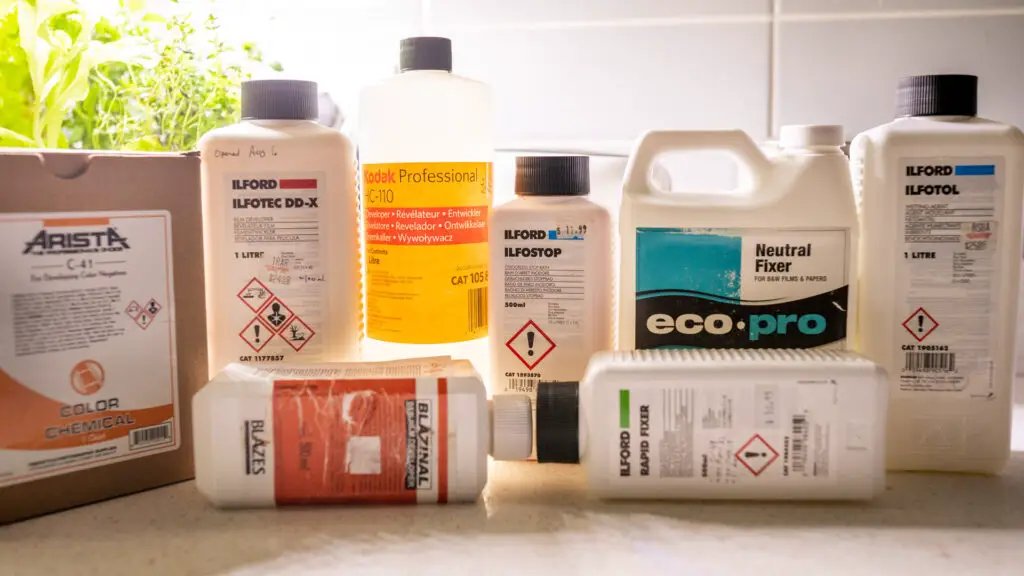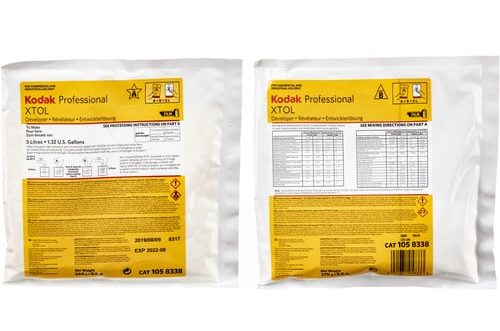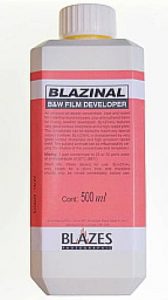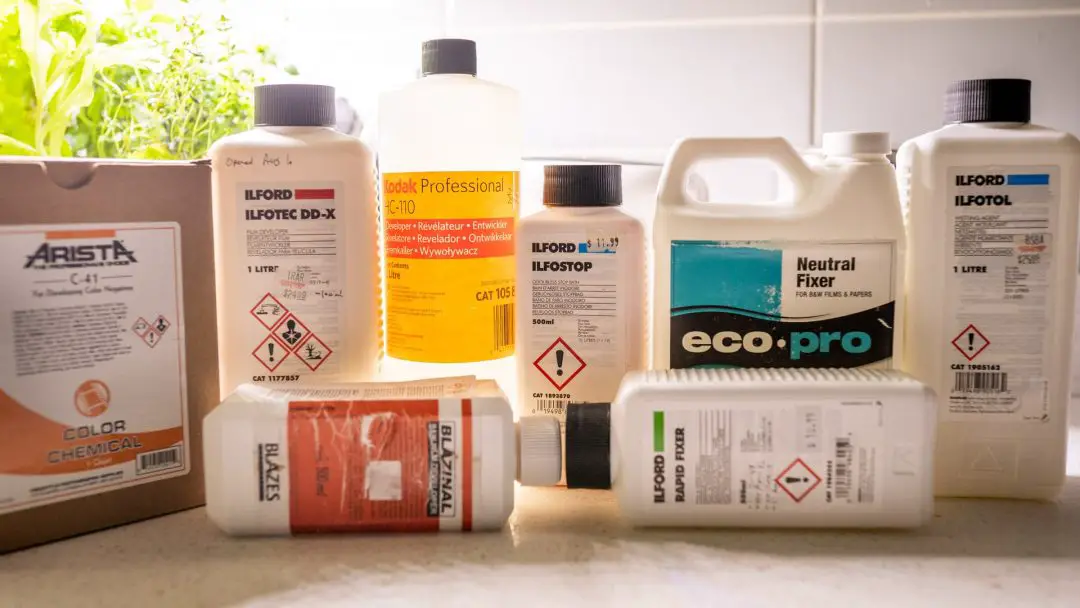There are thousands of different black and white film developer combinations when you’re developing at home. Every single developer on the market is unique, and has its own benefits and drawbacks. This article is going to break down the differences between liquid and powder developers, so that we can at least narrow down some of the options for you. But to get started, here’s the biggest difference between liquid and powder film developers.
Liquid film developers are easier to use than powdered developers, and are typically the best choice for new photographers. Powdered developers are more economical, have a longer shelf life before mixing, and can serve niche purposes, like enhancing sharpness, or creating exceptionally fine-grain negatives.
That’s the biggest difference between the two. For the most part, liquid developers are going to serve a broader audience, and are generally easier to find on store shelves — especially the more common ones, like Rodinal, HC-110, and Ilfotec DD-X.

Are liquid developers better than powder developers?
No one developer is better than any other, but they do all have their specific uses. But the reason most film photographers reach for liquid developers is because you don’t have to mix the chemistry yourself.
Powdered developers usually mix into 5L batches. And to make it last longer, you’ll need to store it either in multiple, sealed bottles, or into one large accordion style bottle that will reduce the amount of oxygen that interacts with the solution. If the solution isn’t mixed at the right temperature, or with enough agitation, the powder may clump in the water and become a complete waste.
Follow the instructions, however, and it will work out — unless you come across a bad batch of Kodak Xtol from when they switched over to a new manufacturing facility.
So liquid developers are typically the most common ones that people buy. They’re readily available, and you can start developing your film in minutes. The concentrated formulas mean that a single 1L bottle can develop as many rolls as a 5L batch from a powdered solution, but take up far less space overall.
The standard liquid developer is HC-110, which is prized for being able to create highly detailed negatives and being exceptionally flexible. This developer was a favorite of Ansel Adams among many other photojournalists and other photographers who wanted quick, satisfactory, and consistent results every time.
A single bottle costs around $35, which can develop 32 rolls of film using Dilution A, or 64 rolls using dilution B. That works out to costing $1.10 – $.55 per roll, making this an outstanding choice
Why would anyone choose to use powdered developers?

There are many benefits of using powdered developers over liquid concentrates. The biggest reason to use powders is the selection of chemicals that are out there! If you’re looking for a specific look, like making some extremely fine-grain negatives, or if you want to push two stops without a noticeable increase in grain and contrast, then you’ll be looking at powdered developers.
Powdered developers can also be the most environmental options out there. Xtol is the most recent film developer ever made, and the solution is built around using Vitamin C to develop film. It also has the benefit of being one of the best all-around developers in existence, known for creating film with incredible tonality and sharpness while also having finer-grain somehow.
Then there’s also the offerings from Photographer’s Formulary, which is the only supplier who still produces an exceptional range of niche B&W developer formulas, including a number from the famous British Journal of Photography editor Geoffrey Crawley. I’ve perused their website for hours, and easily become lost in the dizzying array of possibilities.
Powdered developers are also typically much cheaper. Many of these powdered formulas have been around for decades, or even a century in the case of Kodak D-76, which is the standard developer on which all new film stocks are tested. D-76 can develop approximately 16 rolls of film (using the standard, 1+1 dilution), which works out to cost about 63 cents per roll of film.
What is the best developer for film developing beginners?

The first developer that I recommend all film photographers purchase is Rodinal (also known as Blazinol in Canada. Rodinal is a liquid concentrate film developer that creates that classic sharp and grainy look that most people got into film photography for in the first place. But it’s also the cheapest developer on the market and the one with the longest shelf life.
A single, 500ml bottle costs around $12-$15 and can develop between 50 and 100 rolls of 35mm film, or half that amount for 120. That means a single bottle of Rodinal can develop a roll of film for as little as 12 cents. And you can cut that cost down even further if you dilute the developer further and stand develop the film.
So combine all those factors with the fact that this developer comes in an easy-to-use liquid concentrate form, and there is honestly no better solution for people looking to try out film photography.
When you’re comfortable with developing film, the next developer that I recommend, and personally use for 90% of my film is DD-X. This is one of the more expensive developers, costing twice as much as Rodinal and requiring much more concentrate per roll. This developer works out to cost $1.2-$2.5 per roll of film, which is still far lower than the cost of developing in a lab.
The main feature that keeps me coming back to DD-X is the tonality in the negatives, especially when working with T-grain films like Ilford Delta and Kodak TMax. I don’t know how it does it, but DD-X seems to bring the most out of every single film it touches. It’s flexible, and is incredibly versatile when pushing film.
Final thoughts
There is still an incredible amount of choice when it comes to choosing the right film developer for your needs. Most film photographers will be able to get away with only using liquid developers for the majority of their film photography careers. But if you want to venture into something specific, or if you want the most environmentally-friendly developers, you’ll eventually move into trying out powdered film developers.
The biggest factor that keeps me coming back to liquid developers like DD-X and Rodinal is both the quality of these developers, as well as their convenience. I’ll keep paying a premium for DD-X for my developing because it gets the look and feel that I want to see in my negatives.
Sticking with liquids also means for the most part, I can limit my choices and experiment only with a few different types of developers to really get the process down. That way I know exactly what to expect from the moment I take a photo. And that, to me is powerful. Over time, I will go back to experimenting more with the dizzying array of powdered developers. But for now, there just isn’t enough time in the day.
What’s your favorite developer and film combination? I’d love to hear about it down in the comments below! And if you have any questions about film photography in general, I’m always open to answering your questions in the comments, and even in the growing official Learn Film Photography facebook group!

By Daren
Daren is a journalist and wedding photographer based in Vancouver, B.C. He’s been taking personal and professional photos on film since 2017 and began developing and printing his own photos after wanting more control than what local labs could offer. Discover his newest publications at Soft Grain Books, or check out the print shop.

